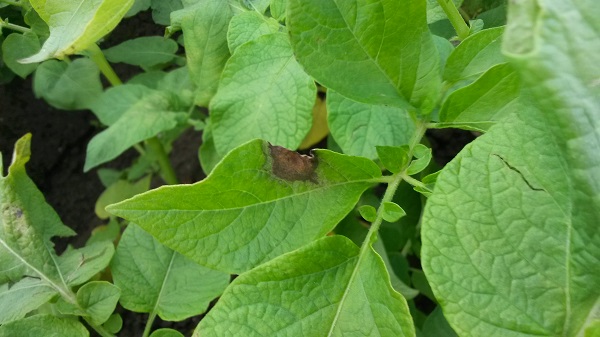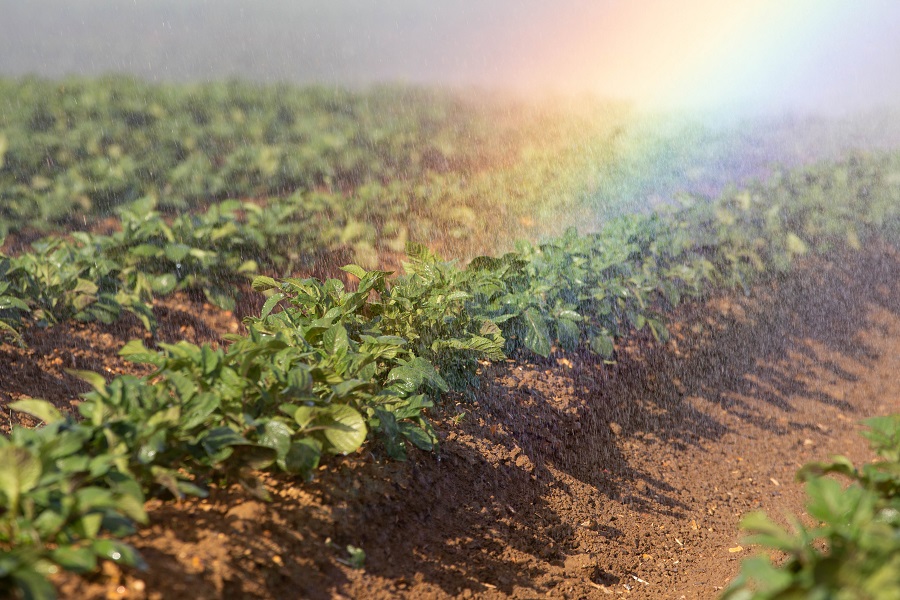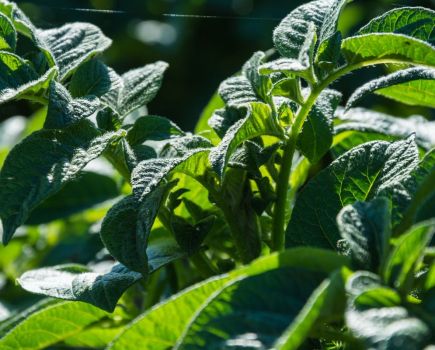Keeping late blight out of the potato crop is becoming an increasingly complex and intensive process. Plant breeders have made great strides in recent years to produce varieties with all the right qualities that would enable a more sustainable, IPM approach. CPM finds out more.
Varieties score 8’s and 9’s for foliage and tuber blight, for all current strains of P. infestans.
By Lucy de la Pasture
Potato breeders are making huge advances in breeding, even without new breeding technologies such as gene editing and transgenics. Yet a glance at the most popular potato varieties being grown in the UK and it’s clear that disease resistance isn’t held in much esteem, particularly where the most devasting fungal pathogen, Phytophthora infestans is concerned.
Maris Piper was first introduced in 1966 and has led the variety rankings for years. It occupied 13.5% of the potato area last season, with 10,000ha more to its name than any other single variety grown in the country. But as far as late blight resistance goes Piper is rated just 4 for foliar blight and 5 for tuber blight, which for all intents and purposes is very susceptible.

Blight-resistant varieties could help conventional growers reduce their input costs and farm sustainably by implementing a more robust IPM strategy.
It’s a trend that’s seen with potato varieties grown for other market outlets. The country’s favourite salad potato is old-timer, Maris Peer, introduced in 1968. It has the third largest acreage in the UK and ranks as a 4 for both foliage and tuber blight resistance.
Breeding for late blight resistance isn’t anything new, it’s been going on for decades, but varieties have never progressed beyond the organic sector to break into conventionally-grown potato markets. But the winds of change are blowing. New blight-resistant varieties are coming through with yields that can now compete with the old favourites, together with good eating and cooking qualities, says Agrico’s executive director Archie Gibson.
The company started developing new potato varieties that are both sustainable and disease-resistant in the 1980s using conventional breeding techniques and is responsible for the UK’s second most popular variety Markies. Earlier this year, Agrico’s ‘Next Generation’ portfolio was launched with a suitable variety for practically every segment – packed white, packed red, packed parti-coloured, salads, crisping and chipping.
As well as the pioneer in the range Carolus, other varieties include Alouette, Levante, Twister, Twinner, Ardeche and Nofy, with Beyonce and Jacky in the pipeline.
“In addition to their uniquely high late blight resistance, these sustainable varieties are high yielding and have outstanding qualities in terms of appearance, taste and versatility. These make the varieties attractive for both growers and customers.
“All the varieties score 8’s and 9’s for foliage and tuber blight, for all the current strains of P. infestans present in the UK. We believe blight-resistant varieties are the future, particularly as chemistry comes under more pressure from both the pathogen and from regulation,” he says.
Archie admits that in the UK, blight-resistance varieties have been pigeon-holed into the organic sector. Historically varieties from the Sarpo blight-resistance breeding programme didn’t eat well because the resistance genes introgressed from wild potatoes introduced a bitter taste. Modern breeding technologies have overcome any flavour or cooking problems and removed a yield drag, so these aren’t factors that can be held against the Next Generation varieties, he explains.
Agrico product manager Gavin Towers charts the evolution of the Agrico blight-resistant varieties, which began with Toluca. This was bred with good foliage blight resistance but the same couldn’t be said for tuber blight, which ultimately was its downfall in the organic sector.
“Toluca was followed by Athlete in 2012, which had some small success in the conventional sector because of its taste, being listed in Marks & Spencer Discovery Range for five years from 2011 -2016. Then came Carolus which has the appearance of a King Edward but it’s a nitrogen hungry-variety, so not ideal in organic regimes, but well-suited to being grown conventionally with the right nutrition and irrigation. It also develops excellent dry matter,” he adds.
Since the pioneers, progress has been rapid and blight resistance has become more robust as resistance genes are stacked in the new varieties rather than relying on single genes, he explains.
The robustness of the Next Generation varieties has been demonstrated at Agrico trial sites in the UK and at Potatoes in Practice, where untreated plants remained blight free throughout the season last year. While in conventional systems it may be too big a leap of faith to cease blight spraying activity completely, Agrico’s sales manager Alex Moore believes blight-resistant varieties offer growers an opportunity to practice the same IPM approaches as in cereal crops and reduce input costs.
“Next Generation are actually conventional varieties that can be grown using less chemistry. We’ve calculated a saving of £400/ha in fungicide inputs is possible while maintaining their yield potential, which is comparable with the yields of other conventionally grown varieties.”
Money saved on blight sprays could be invested in blight monitoring and forecasting equipment, suggests Gavin. “There are no second chances with potato blight, so managing risk is important and moving away from the current seven-day regimes requires gaining confidence in varietal resistance. Applying fungicide cover for when disease pressure is high would be a sensible approach and help protect plant resistance.”
Even though the packing market is probably the slowest to embrace change, one of the Next Generation varieties is already attracting interest from both fresh produce suppliers and commercial growers. Ironically, it’s not the blight-resistance package that comes with Jacky that’s provoking the attention – it’s the variety’s size, shape, taste and high tuber number that’s giving it the chance to break into the salads market.
“Jacky produces around two million small, round tubers per ha which makes it a fantastic salad potato. It has a pale skin and flesh colour comparable to Maris Peer and a good flavour, which comes from Athlete in its parentage,” says Gavin.
Even though breeders are making huge steps in producing varieties that exceed the standard of older varieties but with better blight-resistance profiles, there seems to be a surprising lack of interest in the sustainability of potato production from supermarkets and packers, who continue to support the genetics first introduced 50 years ago, says Alex. He reckons it will probably take another decade before there’s a step-change in mindset and blight resistance becomes as important as septoria resistance now is in wheat varieties today.
It’s in the genes
Sjefke Allefs is director of Agrico Research in Bant, one of the two largest potato-breeding companies in the Netherlands, and he explains the objectives of modern breeding and how it’s been able to progress rapidly since advances in rapid gene sequencing and molecular technologies.
“Our aim is to make late blight resistance stronger by combining major resistance (R) genes. By looking for resistance genes in the potato germplasm held in gene banks, we’ve been able to detect and characterise them using gene mapping information from both published and private sources.
“We can then compare the position of R-genes with the genetic map of the potato chromosome and if the position varies, then it’s probably a different gene. We can then use a bioassay to confirm if this hypothesis is valid. This approach gives us a clear view of the resistance genes available – sometimes these are complicated to introgress into new varieties and sometimes easy,” he explains.
Sjefke explains that Agrico looked at using GM-technologies in their breeding programmes but abandoned that approach when it was clearly unacceptable in the EU. “Manipulating genetic code is like using MS Word to change the text of a document – the public don’t want breeders to manipulate the genetics, they want us to use ‘pdfs’ to read the genetic text. The foundation of molecular biology and advances in technology enable us to read the genetic text quickly. It allows ease of mapping and the characterisation of gene biodiversity so we can find strategies to speed up the breeding process to incorporate combined resistances.
“Not so long ago it would have been unthinkable that cultivars with three or four resistance genes could be produced using classical methods. Now we can stack genes but leave them in their natural genome position,” he explains.
Stacking blight-resistance genes makes a potato cultivar more robust and with a functional resistance at some level, even if a resistance gene is broken, says Sjefke.
“Resistance genes differ in their mode of action and broadness of function – some will function in the canopy and tubers, but others won’t. Some genes have broad-spectrum resistance, and some have a narrow spectrum. Sometimes there’s a price to be paid by the fungus in order to infect a cultivar carrying a resistance gene and it becomes only partially virulent, still causing an infection but a smaller blight lesion.”
Asked whether the aggressiveness of new blight strains, such as 36_A2 and 37_A2, poses as much of a problem to plant breeders as it does to blight chemistry, Sjefke smiles wryly and explains breeders aren’t as concerned with aggressiveness – it’s pathogen virulence that really matters.
“In any clonal lineage there’s a constant gain and loss of virulence in the pathogen population. The interplay between host and pathogen is a running battle and revolves around the recognition of pathogen effector proteins by the host. These are the proteins the late blight fungus needs to build a feeding relationship with the host.
“The host resistance gene recognises the effector proteins secreted by the pathogen avirulence (Avr) genes and this activates plant defences, so there’s a constant cat and mouse game between the two,” he adds.
“Clonal lineages of blight have variances in the virulence spectrum and a lot of virulence is carried by the blight pathogen that isn’t necessary to infect the host plant and in reality, it’s relatively easy to find blight isolates that are capable of breaking resistance genes. So a combination of resistance genes that will lower the damage caused to below the economic threshold, rather than give total protection against blight, is the breeder’s objective,” he explains.
How does an R-gene work?
One of the defence mechanisms of the plant is effector-triggered immunity. Put simply, resistance genes in the host cells are capable of recognising disease breaking in as the fungal pathogen tries to set up a feeding regime with the host cell, explains Sjefke.
“A cascade of cellular processes is then initiated by the R-gene which leads to a ‘burning’ of the single cell that’s being attacked by the invading fungus,” he explains.
“Each fungal spore that lands on the plant only has enough energy within it to attempt the invasion process once or twice, so this hypersensitivity response is a successful mechanism to resist infection. A good analogy is that when the burglar touches the door, the whole room is set on fire.”
This hypersensitive response can be seen under the microscope in the canopy of a blight-resistant variety. It may become visible with the naked eye in cultivars with functional resistance genes as the crop starts to mature,” he says.
“As plants reach the end of their vegetative growth, the hypersensitivity response may not be so active and ‘flecks’ can be seen on plant tissues. This is because the potato plant considers the canopy stage is finished so its plant defences aren’t as sharp – leading to a trailing hypersensitivity response – and the fungus has the time to set up a feeding relationship before it’s shut down by the plant.
“It’s a fact that means growers may have to protect crops with blight-resistance genes later in the season as their defence response slows down. But if the cultivar also has functional tuber blight resistance then there’s less implication from the multiplication of the fungus in the foliage, which can act as a source of inoculum for tuber blight infection in a susceptible variety.”




